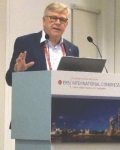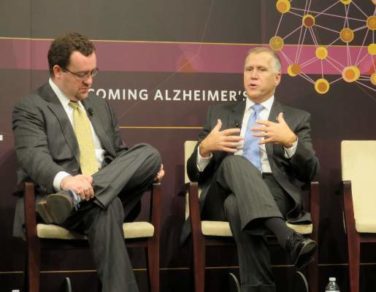AT THE ERS CONGRESS 2016
LONDON (FRONTLINE MEDICAL NEWS) – Phase III evidence confirms the multiple benefits of using a triple, fixed-dose combination (FDC) therapy over standard options in patients with severe chronic obstructive pulmonary disease (COPD), according to a presentation on two trials at the annual congress of the European Respiratory Society.
In the TRINITY trial, the combination of the inhaled corticosteroid (ICS) beclometasone diproprionate (BDP), the long-acting beta-agonist (LABA) formoterol fumarate (FF), and the long-acting muscarinic antagonist (LAMA) glycopyrronium bromide (GB) delivered via a single pressurized metered-dose inhaler (pMDI), was more effective at reducing exacerbations than was tiotropium bromide (Spiriva, Boehringer Ingelheim) monotherapy.
Results of the TRILOGY trial, which were simultaneously published in The Lancet (doi: 10.1016/S0140-6736(16)31354-X ) at the time of their presentation at the ERS meeting, showed that the novel single-inhaler, triple fixed-dose combination could induce greater improvements in lung function when compared to a double fixed-dose combination of BDP and FF (Foster, Chiesi Farmaceutici SpA).
“LAMA monotherapy or ICS/LABA are standard options for treating patients with advanced COPD,” Jørgen Vestbo , MD, president of ERS and professor of respiratory medicine at the University of Manchester (England), said in an interview.
Dr. Vestbo, who was an investigator in both the TRINITY and TRILOGY trials, added that the Global Initiative for Chronic Obstructive Pulmonary Disease (GOLD) guidelines also mention that these drugs can be combined in patients who continue to experience COPD exacerbations. “But the evidence behind that is fairly weak,” he observed.
Although many patients are already being treated with triple therapy, this is via two inhalers, and “there have not been that many really good, long-term outcome studies” that have proven this approach to be the best way to manage those at risk for continued exacerbations of COPD, he said.
Drug companies are now starting to combine these three drugs into one inhaler, however, and this means that registration studies need to be done to get the products licensed, and so “there is an interest in coming up with the evidence,” Dr. Vestbo said.
“What is good about these two studies is that they are both 1-year studies and they are of sufficient size to give quite good estimates … These are studies that we should have done 5 years ago,” he said. Although the ideal is to have patients on as little therapy as possible, the results of TRINITY and TRILOGY now provide much needed evidence that it will work better than either LAMA or ICS/LABA.
The piece of evidence that is still missing is what the benefit, if any, is over a LAMA/LABA combination, a fact noted during discussion following the presentations of these data at the ERS meeting and in an editorial by Peter Calverley, MD, of the University of Liverpool (England) that accompanied the published TRILOGY findings ( Lancet. 2016;388:937-8 ). There also is a question over whether twice daily is really better than once daily dosing, or vice versa.
“Until these next studies become available, we can be comforted by the knowledge that three therapies can be combined in a single inhaler which offers more effective therapy than at least one of the recommended treatment regimens for patients with severe COPD,” Dr. Calverley observed in reference to TRILOGY only.
Dr. Vestbo noted that at the time the TRILOGY and TRINITY studies were designed, there wasn’t the evidence from other studies such as the FLAME study ( N Engl J Med. 2016. doi: 10.1056/NEJMoa1516385 ), showing the benefit of the LABA/LAMA combination over ICS/LABA. The TRILOGY and TRINITY studies “give that degree of evidence that was needed,” he said.
“I am not sure that the guidelines [for treating severe COPD] will change much, but at least they can say with better certainty that you can use the triple,” he added.
TRINITY – can triple better LAMA monotherapy?
The TRINITY study looked at whether patients with GOLD 3-4 COPD would be better off treated with LAMA monotherapy (tiotropium 18 mcg, one puff per day), the triple fixed-dose combination of BDP (100 mcg), FF (6 mcg), and GB (12.5 mcg) given via the novel pressurized metered-dose inhaler (two puffs twice daily), or a “free” triple combination of BDP (100 mcg) and FF (6 mcg) given via one pressurized metered-dose inhaler (two puffs daily) plus the same dose of the once-daily LAMA.
In all, 2,690 patients were randomized to these three treatments arms. The mean age of patients was 63 years and the majority (74%-77%) were men, with an average FEV1 predicted of 36% and one COPD exacerbation in the past year. Just under half of the study population were current smokers. Most (75%) had received prior treatment with an ICS/LABA combination, with about 11% receiving LAMA, and the rest either ICS/LAMA (3%), or LABA/LAMA (12%)
The annualized exacerbation rate (the primary endpoint) was 0.457 in the 1,077 patients who were treated with the triple fixed-dose combination versus 0.571 in the 1,074 patients who received tiotropium alone. The rate ratio was 0.8 indicating a 20% reduction in exacerbations was achieved (P = .003).
The annualized exacerbation rate in the 532 patients given the “free” triple combination (BDP/FF plus tiotropium) was 0.452, with a rate ratio of 0.790 (P =.010) versus those who received the LAMA as monotherapy.
There was no significant difference between the two triple combination strategies.
Presenting these data, Dr. Vestbo noted that the benefit was seen in preventing both severe and moderate COPD exacerbations. Significantly improved lung function, as measured by the change in FEV1 from baseline to week 52, was also observed to a greater degree with the triple therapy approaches than with the LAMA monotherapy.
“All three treatments were well tolerated and there were no particular safety concerns in this study,” he said.
TRILOGY – are three drugs better than two?
In contrast to the TRINITY study, the TRILOGY study looked at whether patients with severe COPD would be better off taking an ICS/LABA or the new triple fixed-dose combination pressurized metered-dose inhaler.
Just over 1,200 patients were recruited into the study, which had two co–primary endpoints: change from baseline to week 26 in predose morning FEV1 and 2-hour postdose FEV1, and the change in transition dyspnea index focal score at week 26.
Results showed that the triple fixed-dose combination improved predose FEV1 by 0.081 L and 2-hour postdose FEV1 by 0.117 L compared with the ICS/LABA combination (P less than .001 for both comparisons). Mean transition dyspnea index scores were 1.71 and 1.50, with a nonsignificant difference of 0.21.
“To be honest, I don’t think we had expected that [the triple combination] would mean much for patients, but we were hoping there would be a significant increase in lung function and a reduction of symptoms,” Dr. Vestbo said about the TRILOGY study. “What we saw was there was [symptomatic improvement] but it was not quite as impressive as we thought, but we reduced exacerbations.”
There was a significant, 23% reduction in the annualized exacerbation rate via the triple combination versus the ICS/LABA combination (0.41 vs 0.53, adjusted rate ratio 0.77, P = .005).
The triple approach was well tolerated, with no increase in adverse events versus the dual combination. The results support the idea that instead of giving patients an ICS/LABA at the start, better disease control can be achieved with a triple fixed-dose combination, Dr. Vestbo suggested.
Writing in The Lancet, Dr. Calverley noted: “The inability to meet one part of a co–primary endpoint clouds the interpretation of the other findings in the study, a familiar problem in COPD trials.” He added that there was a significant difference in the overall St George’s Respiratory Questionnaire scores favoring the triple over double therapy.
Chiesi Farmaceutici SpA funded the studies. Dr. Vestbo was an investigator for both TRINITY and TRILOGY and has received honoraria for advising and presenting from AstraZeneca, Boehringer Ingelheim, Chiesi, GlaxoSmithKline, and Novartis. Dr. Calverley has consulted for Boehringer Ingelheim, GlaxoSmithKline, and AstraZeneca.





